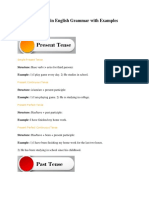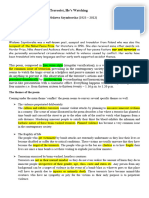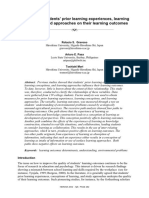100%(1)100% found this document useful (1 vote)
568 viewsLiterary Techniques A Bird Came Down The Walk by Emily Dickinson
Literary Techniques A Bird Came Down The Walk by Emily Dickinson
Uploaded by
Noël PereraThe poem uses various literary techniques to describe a bird's actions in vivid detail. It employs imagery to create a clear picture of the bird eating, drinking dew, and hopping. Personification attributes human qualities like emotions to the bird. Similes liken the bird's movement to being in danger or butterflies. Metaphors, like comparing the bird's head to soft velvet, create sensory images. Alliteration adds musicality. Enjambment mirrors the bird's continuous movements. Symbolism represents nature's interconnectedness. Contrast emphasizes small moments' significance. Irony exists in the difference between the bird's natural behavior and the speaker's human actions.
Copyright:
© All Rights Reserved
Available Formats
Download as DOCX, PDF, TXT or read online from Scribd
Literary Techniques A Bird Came Down The Walk by Emily Dickinson
Literary Techniques A Bird Came Down The Walk by Emily Dickinson
Uploaded by
Noël Perera100%(1)100% found this document useful (1 vote)
568 views3 pagesThe poem uses various literary techniques to describe a bird's actions in vivid detail. It employs imagery to create a clear picture of the bird eating, drinking dew, and hopping. Personification attributes human qualities like emotions to the bird. Similes liken the bird's movement to being in danger or butterflies. Metaphors, like comparing the bird's head to soft velvet, create sensory images. Alliteration adds musicality. Enjambment mirrors the bird's continuous movements. Symbolism represents nature's interconnectedness. Contrast emphasizes small moments' significance. Irony exists in the difference between the bird's natural behavior and the speaker's human actions.
Original Title
Literary techniques A bird came down the Walk by Emily Dickinson
Copyright
© © All Rights Reserved
Available Formats
DOCX, PDF, TXT or read online from Scribd
Share this document
Did you find this document useful?
Is this content inappropriate?
The poem uses various literary techniques to describe a bird's actions in vivid detail. It employs imagery to create a clear picture of the bird eating, drinking dew, and hopping. Personification attributes human qualities like emotions to the bird. Similes liken the bird's movement to being in danger or butterflies. Metaphors, like comparing the bird's head to soft velvet, create sensory images. Alliteration adds musicality. Enjambment mirrors the bird's continuous movements. Symbolism represents nature's interconnectedness. Contrast emphasizes small moments' significance. Irony exists in the difference between the bird's natural behavior and the speaker's human actions.
Copyright:
© All Rights Reserved
Available Formats
Download as DOCX, PDF, TXT or read online from Scribd
Download as docx, pdf, or txt
100%(1)100% found this document useful (1 vote)
568 views3 pagesLiterary Techniques A Bird Came Down The Walk by Emily Dickinson
Literary Techniques A Bird Came Down The Walk by Emily Dickinson
Uploaded by
Noël PereraThe poem uses various literary techniques to describe a bird's actions in vivid detail. It employs imagery to create a clear picture of the bird eating, drinking dew, and hopping. Personification attributes human qualities like emotions to the bird. Similes liken the bird's movement to being in danger or butterflies. Metaphors, like comparing the bird's head to soft velvet, create sensory images. Alliteration adds musicality. Enjambment mirrors the bird's continuous movements. Symbolism represents nature's interconnectedness. Contrast emphasizes small moments' significance. Irony exists in the difference between the bird's natural behavior and the speaker's human actions.
Copyright:
© All Rights Reserved
Available Formats
Download as DOCX, PDF, TXT or read online from Scribd
Download as docx, pdf, or txt
You are on page 1of 3
Literary techniques - A bird came down the Walk" by Emily
Dickinson
Imagery: The poem is rich in sensory imagery, describing the bird's
actions in detail, such as biting the angle worm, eating it raw, drinking
dew, and hopping to the wall. These vivid descriptions create a clear
and visual picture of the bird's movements and interactions with its
environment.
Personification: The speaker personifies the bird by attributing human-
like qualities and emotions to it. For example, the bird's eyes are
described as "frightened beads," and the bird is said to "row" and
"unroll his feathers." This personification helps readers relate to the
bird and understand its behavior from a human perspective.
Simile: The poem contains similes to make comparisons between the
bird's actions and other elements. For example, the bird's movement is
"like one in danger," and its motion is "like butterflies off banks of
noon." Similes enhance the reader's understanding of the bird's
behavior by likening it to familiar experiences or phenomena.
Metaphor: The comparison of the bird's head to "stirred velvet" is a
metaphor that creates a sensory and tactile image, emphasizing the
softness of the bird's feathers.
Alliteration: Alliteration is the repetition of consonant sounds at the
beginning of words. In this poem, alliteration can be found in phrases
like "rowed him softer home," "Butterflies, off Banks of Noon," and
"leap, plashless as they swim." Alliteration adds a musical quality to the
poem and reinforces the rhythm.
Enjambment: The poem uses enjambment, where lines continue
without a pause into the next line, creating a sense of continuity and
fluidity. This technique mirrors the bird's natural and uninterrupted
movements.
Symbolism: While not as overt as other techniques, the poem uses
symbolism to represent the bird as a symbol of nature and the
interconnectedness of all living creatures. The bird's actions and
interactions with its environment reflect the delicate balance of the
natural world.
Contrast: The poem employs contrast between the bird's small,
seemingly insignificant actions and the grand natural elements it is
compared to, such as oars dividing the ocean and butterflies off banks
of noon. This contrast emphasizes the beauty and significance of even
the smallest moments in nature.
Irony: The poem contains an element of irony in the contrast between
the bird's natural behavior and the speaker's human gestures of
offering a crumb. The bird's response to the offered crumb is
unexpected, and this irony adds depth to the poem.
You might also like
- The Pigtail by William Makepeace ThackeryDocument3 pagesThe Pigtail by William Makepeace ThackeryGayan BandaraNo ratings yet
- The Earthen GobletDocument3 pagesThe Earthen GobletRameshkumar Nivarshana100% (3)
- 4EA1 01R Que 20200305Document28 pages4EA1 01R Que 20200305Noël Perera100% (2)
- O - L English - Test 10 ActivitiesDocument12 pagesO - L English - Test 10 ActivitiesNoël Perera100% (8)
- Appreciation of English Literary Texts: G.C.E..Ordinary LevelDocument20 pagesAppreciation of English Literary Texts: G.C.E..Ordinary LevelRobert Miller100% (1)
- PDFDocument5 pagesPDFRajesh Kumar100% (1)
- Figurative LanguageDocument4 pagesFigurative Languageapi-50704312750% (2)
- Evaluative Meanings in Literary Texts The First Step Towards Appraisal StylisticsDocument20 pagesEvaluative Meanings in Literary Texts The First Step Towards Appraisal StylisticsLígia Lima100% (1)
- The EagleDocument6 pagesThe EagleGAMAGE SARANAPALA50% (2)
- Literature Exam Papers For Grade 10Document8 pagesLiterature Exam Papers For Grade 10Rasbahan Manshaf0% (1)
- Voicing The SubalternDocument248 pagesVoicing The SubalternTEACHER JOSEPH KANYINo ratings yet
- O - L English - Test 9 ActivitiesDocument11 pagesO - L English - Test 9 ActivitiesNoël Perera100% (4)
- A.L English SyllabusDocument12 pagesA.L English SyllabusNoël PereraNo ratings yet
- Twilight of A Crane Drama AnalysisDocument8 pagesTwilight of A Crane Drama AnalysisLuchithaNo ratings yet
- IC AnalysisDocument4 pagesIC AnalysisMd.Rabiul IslamNo ratings yet
- Year 8 English Unit Plan Autobiography - BiographyDocument5 pagesYear 8 English Unit Plan Autobiography - Biographyapi-333849174No ratings yet
- Analysis - A Bird, Came Down The WalkDocument3 pagesAnalysis - A Bird, Came Down The WalkNoël Perera100% (1)
- A Bird Came Down The WalkDocument4 pagesA Bird Came Down The WalkJunko100% (1)
- Essay Type Question A Bird, Came Down The WalkDocument3 pagesEssay Type Question A Bird, Came Down The WalkNoël Perera100% (2)
- A Bird Came Down The Walk ...Document3 pagesA Bird Came Down The Walk ...Rameshkumar NivarshanaNo ratings yet
- A Bird Came Down The Walk AnalysisDocument4 pagesA Bird Came Down The Walk AnalysisRohana Fernando92% (12)
- Analysis of Tennyson's Poem EagleDocument3 pagesAnalysis of Tennyson's Poem EagleRohana C. Fernando92% (13)
- A/L English Literature PaperDocument4 pagesA/L English Literature PaperNoël Perera100% (1)
- Analysis of To The Poem To The Nile by KeatsDocument17 pagesAnalysis of To The Poem To The Nile by KeatsRohana Fernando100% (6)
- The EagleDocument8 pagesThe Eaglesaksi76@gmail.com100% (1)
- 2021 AL General English Past PaperDocument19 pages2021 AL General English Past PaperDimansa Hettiarachchi100% (1)
- Worksheet: To The Nile by John KeatsDocument7 pagesWorksheet: To The Nile by John Keatshamlet in the tea cup80% (5)
- Anne Frank HuisDocument6 pagesAnne Frank Huisxalba14No ratings yet
- The Lumber Room (Rom)Document9 pagesThe Lumber Room (Rom)LilianaNo ratings yet
- Literature Kalutara District 2019 Past PaperDocument4 pagesLiterature Kalutara District 2019 Past PaperGAMAGE SARANAPALANo ratings yet
- To The Evening StarDocument4 pagesTo The Evening Starsudeepa pathirana100% (5)
- Review of The Nature Poems in The SyllabusDocument2 pagesReview of The Nature Poems in The SyllabusRohana C. FernandoNo ratings yet
- Breakfast by Jacques PrevertDocument2 pagesBreakfast by Jacques PrevertNethmi Ranasinghe100% (5)
- Grade 11 English Literature Paper 2020 3rd Term Test Southern ProvinceDocument14 pagesGrade 11 English Literature Paper 2020 3rd Term Test Southern ProvinceZeidan NalimNo ratings yet
- Luber RoomDocument5 pagesLuber RoomFarha AhmedNo ratings yet
- Fear Gabriela Mistral Lesson ResourcesDocument5 pagesFear Gabriela Mistral Lesson ResourceskassivanesanNo ratings yet
- Essay Type Question 1 - To The NileDocument2 pagesEssay Type Question 1 - To The NileNoël Perera100% (1)
- The Fisherman Mourned by His WifeDocument4 pagesThe Fisherman Mourned by His WifeRuwan De Silva91% (11)
- 12 Tenses in English Grammar With ExamplesDocument3 pages12 Tenses in English Grammar With ExamplesMohammad Fadli ZakariaNo ratings yet
- Wedding Photographs by Jean Arasanayagam AnalysisDocument2 pagesWedding Photographs by Jean Arasanayagam Analysisgtmlgtml75% (4)
- Farewell To Barn and Stack and Tree Exercises 1Document3 pagesFarewell To Barn and Stack and Tree Exercises 1amanullahahmed971100% (1)
- Grade 10 English Literature 3rd Term Test Paper 2020 Southern ProvinceDocument5 pagesGrade 10 English Literature 3rd Term Test Paper 2020 Southern ProvinceVihara NeeradiNo ratings yet
- Appreciation of English Literary Texts Grade 10 - Model PaperDocument5 pagesAppreciation of English Literary Texts Grade 10 - Model PaperBatuka Mary100% (1)
- 9th Class Notes (Questions and Answers and MCQ's of 6-10 Chapters)Document27 pages9th Class Notes (Questions and Answers and MCQ's of 6-10 Chapters)Cyra Ansari75% (8)
- Unseen PoetryDocument5 pagesUnseen PoetryMakanakaNo ratings yet
- Worksheet On The Eagle by Alfred Lord TennysonDocument1 pageWorksheet On The Eagle by Alfred Lord Tennysonmoses bandick100% (2)
- Stench of Kerosene 21.11.2020Document8 pagesStench of Kerosene 21.11.2020- ʟᴏɴᴇ ᴡᴏʟғ -100% (2)
- The Terrorist, He's Watching ....................Document3 pagesThe Terrorist, He's Watching ....................Rameshkumar NivarshanaNo ratings yet
- Royal College Grade 11 English Literature Second Term Paper 2022Document4 pagesRoyal College Grade 11 English Literature Second Term Paper 2022Nilanthi Bandara100% (1)
- Evening StarDocument6 pagesEvening Starhaziqhazri70% (10)
- Synthesis of SentencesDocument3 pagesSynthesis of SentencesCheryl Chaudhari100% (2)
- Father To SonDocument3 pagesFather To SonSanjana KumariNo ratings yet
- Character Sketch of Grace in Vendor of SweetsDocument2 pagesCharacter Sketch of Grace in Vendor of SweetsDMSK INDIKA100% (1)
- Summaries of All Three Novels PresentationDocument65 pagesSummaries of All Three Novels PresentationDinidu Nisal100% (1)
- Nallur by Jean ArasanayagamDocument3 pagesNallur by Jean ArasanayagamThamilaNo ratings yet
- 1-The Rainbow By: William WordsworthDocument3 pages1-The Rainbow By: William WordsworthSalama Ali Salama100% (1)
- To The Nile - ThemesDocument4 pagesTo The Nile - ThemesNoël Perera100% (1)
- Vendor of Sweets Model AnswerDocument2 pagesVendor of Sweets Model AnswerUpUl Kumarasinha100% (13)
- This Play Is A Criticism On The Hypocritical Attitude of Upper ClassDocument3 pagesThis Play Is A Criticism On The Hypocritical Attitude of Upper ClassHira KhanNo ratings yet
- O - L English Literature Questions BankDocument44 pagesO - L English Literature Questions BankGAMAGE SARANAPALA100% (1)
- By Sir Cecil Spring RiceDocument2 pagesBy Sir Cecil Spring RiceHaitham AnwarNo ratings yet
- Lit Analysis PDFDocument7 pagesLit Analysis PDFvinu100% (2)
- Past Paper Question For Appreciation of English LiteratureDocument16 pagesPast Paper Question For Appreciation of English LiteratureAafiya Yasir100% (1)
- Conj 8Document4 pagesConj 8Kannan Letchmanan100% (1)
- Phonetics 9 - Strong and Weak SyllablesDocument88 pagesPhonetics 9 - Strong and Weak SyllablesDê Béo Ăn Thịt100% (1)
- A Bird Came DownDocument4 pagesA Bird Came DownlichousingNo ratings yet
- Analysis of Emily DickinsonDocument2 pagesAnalysis of Emily DickinsonZiedNo ratings yet
- To The Nile - ComprehensionDocument7 pagesTo The Nile - ComprehensionNoël PereraNo ratings yet
- To The Nile - ThemesDocument4 pagesTo The Nile - ThemesNoël Perera100% (1)
- MotivationDocument3 pagesMotivationNoël PereraNo ratings yet
- Essay Type Question 1 - To The NileDocument2 pagesEssay Type Question 1 - To The NileNoël Perera100% (1)
- Ol Model Paper Abdul HaiDocument9 pagesOl Model Paper Abdul HaiNoël PereraNo ratings yet
- Test 12Document1 pageTest 12Noël PereraNo ratings yet
- Gce Ol Model 2011 Part 1 8th Nov 20111Document7 pagesGce Ol Model 2011 Part 1 8th Nov 20111Noël PereraNo ratings yet
- Prior LearningDocument8 pagesPrior LearningNoël PereraNo ratings yet
- English Paper I IIDocument11 pagesEnglish Paper I IINoël PereraNo ratings yet
- A Study of Teaching Listening by Dara Yusnida Asnawi Muslem Abdul MananDocument18 pagesA Study of Teaching Listening by Dara Yusnida Asnawi Muslem Abdul MananNoël PereraNo ratings yet
- O - L English - Test 12 ActivitiesDocument21 pagesO - L English - Test 12 ActivitiesNoël PereraNo ratings yet
- Adult Learner - CulturalDocument11 pagesAdult Learner - CulturalNoël PereraNo ratings yet
- II English Language - II: Test 9Document8 pagesII English Language - II: Test 9Noël PereraNo ratings yet
- Examiners' Report Principal Examiner Feedback January 2020Document9 pagesExaminers' Report Principal Examiner Feedback January 2020Noël PereraNo ratings yet
- YouTube Channels and Websites For ICT Lessons in SinhalaDocument3 pagesYouTube Channels and Websites For ICT Lessons in SinhalaNoël PereraNo ratings yet
- Examiners' Report Principal Examiner Feedback January 2020Document6 pagesExaminers' Report Principal Examiner Feedback January 2020Noël PereraNo ratings yet
- II English Language - II: Test 9Document8 pagesII English Language - II: Test 9Noël PereraNo ratings yet
- Examiners' Report Principal Examiner Feedback January 2020Document10 pagesExaminers' Report Principal Examiner Feedback January 2020Noël PereraNo ratings yet
- English - Special Evaluation Test - Ananda CollegeDocument9 pagesEnglish - Special Evaluation Test - Ananda CollegeNoël PereraNo ratings yet
- OL Activities Part 1Document25 pagesOL Activities Part 1Noël Perera100% (1)
- Lesson 12 - OnomatopoeiaDocument2 pagesLesson 12 - Onomatopoeiaapi-265318262No ratings yet
- Metaphorical Translation Strategies of Bahasa Indonesia Into English On Contemporary Indonesian Poetry Translated by Harry AvelingDocument5 pagesMetaphorical Translation Strategies of Bahasa Indonesia Into English On Contemporary Indonesian Poetry Translated by Harry AvelingRahma Yulia SyahfitriNo ratings yet
- English 8 - Third Quarter ExaminationDocument2 pagesEnglish 8 - Third Quarter ExaminationLorna Lopez CalmaNo ratings yet
- Entity-Relationship Model: Togu Turnip - Institut Teknologi Del Minggu 03 Sesi 01Document46 pagesEntity-Relationship Model: Togu Turnip - Institut Teknologi Del Minggu 03 Sesi 01Sonya SipahutarNo ratings yet
- CP English AnswersDocument13 pagesCP English AnswersMehwish Riaz KashifNo ratings yet
- Poetic Device For CBSE IXDocument4 pagesPoetic Device For CBSE IXDharanidhar469182% (17)
- Figures of Speech: This Photo by Unknown Author Is Licensed Under CC BY-NC-NDDocument30 pagesFigures of Speech: This Photo by Unknown Author Is Licensed Under CC BY-NC-NDDevika SNo ratings yet
- Lesson Plan in Remedial InstructionDocument47 pagesLesson Plan in Remedial InstructionRose Ann BurceNo ratings yet
- Figures of SpeechDocument19 pagesFigures of SpeechNestlie Joy AlimanNo ratings yet
- Preface To Lyrical BalladsDocument2 pagesPreface To Lyrical BalladsABHISHEK JHANo ratings yet
- Six Theories of Culture and How They Relate To Language (Duranti Ch.2)Document28 pagesSix Theories of Culture and How They Relate To Language (Duranti Ch.2)Ibrar Ahmed WazirNo ratings yet
- Metaphor Comprehension As Problem SolvingDocument22 pagesMetaphor Comprehension As Problem Solvingerazmo289No ratings yet
- Christian Zöhrer: Exploring The Unforeseen-Porosity As A ConceptDocument2 pagesChristian Zöhrer: Exploring The Unforeseen-Porosity As A ConceptIzzac AlvarezNo ratings yet
- Translation Analysis of Irony in Tenggelamnya Kapal Van Der Wijck by Hamka (Skripsi Okta) Final - OkDocument81 pagesTranslation Analysis of Irony in Tenggelamnya Kapal Van Der Wijck by Hamka (Skripsi Okta) Final - Okktaviankhairy4No ratings yet
- Assignment of English PDFDocument2 pagesAssignment of English PDFbasilNo ratings yet
- Creative Writing Module 5Document8 pagesCreative Writing Module 5Elnevith DejarmeNo ratings yet
- Linguistic Study of Automotive Vocabulary in English and Uzbek LanguagesDocument4 pagesLinguistic Study of Automotive Vocabulary in English and Uzbek LanguagesCentral Asian StudiesNo ratings yet
- More Than Cool Reason A Field Guide To Poetic MetaphorDocument20 pagesMore Than Cool Reason A Field Guide To Poetic MetaphorVuong Huu VinhNo ratings yet
- Bartleys Figurative LanguageDocument58 pagesBartleys Figurative Languagemmiljana95No ratings yet
- 7.2 - Lec - Refining The Entity Relationship DiagramDocument12 pages7.2 - Lec - Refining The Entity Relationship DiagramMichael Charles UlsonNo ratings yet
- Test On StylisticsDocument42 pagesTest On StylisticsАйгерим Зайнкабылова100% (4)
- Literary Dictionary - 211007 - 215751Document56 pagesLiterary Dictionary - 211007 - 215751Nethuki JayasinhaNo ratings yet
- Simile MetaphorDocument16 pagesSimile Metaphorapi-253952864No ratings yet
- Educ 38 Sir Acoriba ExercisesDocument17 pagesEduc 38 Sir Acoriba ExercisesRenalyn Samuya Jardio100% (1)
- Figure of SpeechDocument27 pagesFigure of SpeechSabel Ross CaliliwNo ratings yet
- Five Stars Workbook - Free Giveaway FINAL PDFDocument11 pagesFive Stars Workbook - Free Giveaway FINAL PDFHarpreet SinghNo ratings yet













































































































